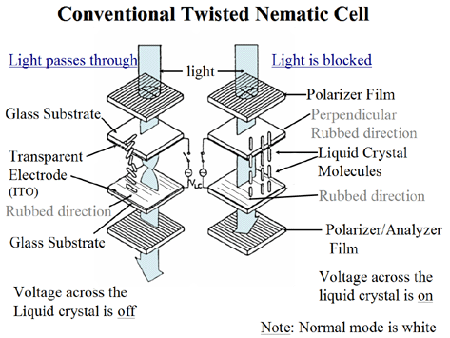LCD – For the Novice and the Expert
by Kristopher Kubicki on September 4, 2003 12:13 AM EST- Posted in
- Displays
In the beginning
LCD stands for Liquid Crystal Display. Incredibly, this technology has its roots in 1888 when Friedrich Reinitzer melted cholesteryl benzoate. It became a cloudy liquid which then turned into a blue opaque substance when cooled. Almost 80 years later, RCA began to tinker with the idea of using these liquid crystals in watches. Then, in 1968, the RCA team created a working liquid crystal timepiece, albeit they were still some years off from creating large scale devices.To briefly go over how LCDs are possible, we have to understand Reinitzer’s discovery 115 years ago. Cholesteryl benzoate is a very tightly packed fibrous material. Typically, it arranges itself in a tight helix pattern that is “twisted” together. Although LCDs today don’t use cholesteryl benzoate, the materials used today share some similar properties. Modern LCDs are composed of a pool of twisted liquid crystals in front of every sub-pixel on the display. Applying various degrees of current to the liquid crystals untwists them ever slightly (enough to allow light to pass).

This very important principal in LCD technology is called the twisted nematic field effect. The important thing to understand is that LCDs do not generate light; they simply allow or inhibit light from passing through a certain place on a substrate.
When the liquid crystal is untwisted, light from the backlight passes it. There are no white sub-pixels on the display, so the color of the red, blue or green sub-pixel shines through. We no longer use cholesteryl benzoate, but rather Ferroelectric liquid crystals. These crystals are arranged in a very tight helix arrangement, which allows them to twist and untwist very rapidly. Even further advances in LCDs have brought us surface-stabilized ferroelectric liquid crystals, which form a slightly different natural pattern, but still allows for an electrical current to untwist the crystal.










63 Comments
View All Comments
Anonymous User - Thursday, September 4, 2003 - link
A good article.I my self use CML174.Made a lot of difference to my eyes compared to CRT.
Anonymous User - Thursday, September 4, 2003 - link
Outstanding reading, thanks.mechBgon - Thursday, September 4, 2003 - link
Nice work, Kristopher. : )KristopherKubicki - Thursday, September 4, 2003 - link
#5 fixed it - sorry.#7 fixed that one too. Yeah rubbing pixels really doesnt do much good. I think NewEgg is going to be pissed when they find out I messed up their monitor pretty good.
#6 Say it aint so!! We want to be the only ones ;)
Kristopher
Shalmanese - Thursday, September 4, 2003 - link
Finally! It took long enough for you to get this out :). Great article, finally an article about LCD's which isn't full of opinion and hearsay.dvinnen - Thursday, September 4, 2003 - link
ok, maybie you did mean that. Hard to tell, you say you scuffed the monitor, then go on to tell other people how to do it...I problay just need some sleep...
dvinnen - Thursday, September 4, 2003 - link
Rubbing the pixils does more good then harm then?<<<Personally, it seems that rubbing the pixels does more good than harm so continue at your own risk.>>>
Might want to fix that one
dvinnen - Thursday, September 4, 2003 - link
good to hear it. Seems like alot of the hardware sites are getting there act together.Anonymous User - Thursday, September 4, 2003 - link
On page 6, where you talk about the cables in the picture (the sentence right below the picture), shouldn't the good cable be the *upper* one or am I missing something?KristopherKubicki - Thursday, September 4, 2003 - link
Yeah, new editors and kind of a revamped AT staff. We went through a lull period after we lost Matthew, but now we have some really good writers and a lot of great content to write about.Just wait till Computex and COMDEX - 3 and 4 reviews per day sounds about right.
Kristopher